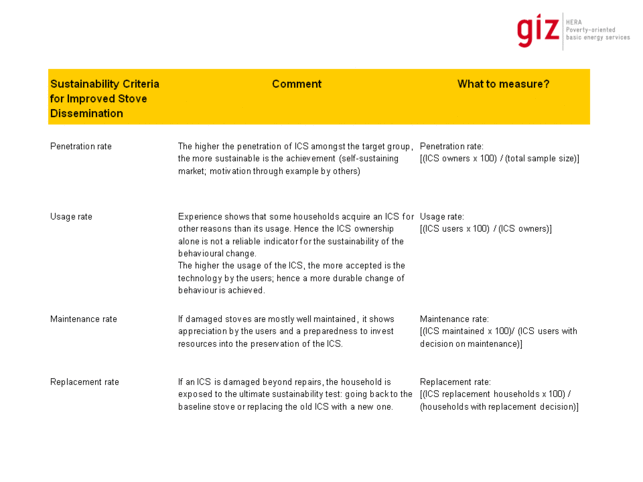Difference between revisions of "Sustainability Assessment of Improved Household Cookstove Dissemination"
***** (***** | *****) m (moved Sustainability of cookstoves to Sustainability of Cookstoves) |
***** (***** | *****) m |
||
| Line 3: | Line 3: | ||
= Sustainability Assessment of Improved Cookstove Dissemination<br/> = | = Sustainability Assessment of Improved Cookstove Dissemination<br/> = | ||
| − | The '''Development Assistance Committee''' of the '''Organisation for Economic Co-operation and Development ([http://www.oecd.org/ OECD]-DAC)''' defines sustainability as: | + | <u>The '''Development Assistance Committee''' of the '''Organisation for Economic Co-operation and Development ([http://www.oecd.org/ OECD]-DAC)''' defines sustainability as:</u> |
#the continuation of benefits from a development intervention after major assistance has been completed | #the continuation of benefits from a development intervention after major assistance has been completed | ||
| Line 33: | Line 33: | ||
(see diagram below for details). | (see diagram below for details). | ||
| + | |||
| + | |||
The importance of building up markets for '''improved cooking stoves (ICS)''' is one of the lessons learnt during the last decade. However, not only are the production and sale of a big number of improved stoves important for a sustainable stove market but also the stoves’ usage and, ultimately, their replacement when broken. | The importance of building up markets for '''improved cooking stoves (ICS)''' is one of the lessons learnt during the last decade. However, not only are the production and sale of a big number of improved stoves important for a sustainable stove market but also the stoves’ usage and, ultimately, their replacement when broken. | ||
| Line 56: | Line 58: | ||
| | ||
| − | [[File:GIZ HERA Sustainability Criteria.gif|center| | + | [[File:GIZ HERA Sustainability Criteria.gif|center|643x489px|GIZ HERA Sustainability Criteria.gif]] |
Revision as of 12:47, 30 July 2012
--> Back to Overview GIZ HERA Cooking Energy Compendium
Sustainability Assessment of Improved Cookstove Dissemination
The Development Assistance Committee of the Organisation for Economic Co-operation and Development (OECD-DAC) defines sustainability as:
- the continuation of benefits from a development intervention after major assistance has been completed
- the probability of continued long term benefits
- the resilience to risks of the net benefit flows over time.”
Thus, a development project would be considered sustainable if its achievements continue in the long term. It needs to generate measurable impact and outcomes even after all external support has ended. An ongoing project’s sustainability can only be estimated by approximating the project’s long-term impacts.
Since the late seventies, stove projects have been carried out all over the world. Experiences on dissemination and promotion of improved cooking stoves are numerous. Many of these projects and experiences have been evaluated by implementing agencies or by donors. One comprehensive evaluation of successes and failures was carried out by the World Bank in 1994.
Over the last 30 years, GIZ has gained a lot of experiences in supporting the dissemination of efficient stoves. Based on its own lessons learnt and with reference to the World Bank review, GIZ’s programme on Poverty-oriented Basic Energy Services (HERA) has now developed a detailed list with indicators for assessing sustainability.
GIZ HERA differentiates between two sustainability categories:
1. Sustainability criteria, which assess whether the changes induced by the project are sustainable or not; and
2. Sustainability factors, which influence the probability of achieving sustainable results.
Sustainability Criteria
Four elements are used as measurable sustainability criteria for improved cookstove programs:
- penetration rate
- usage rate
- maintenance rate
- replacement rate
(see diagram below for details).
The importance of building up markets for improved cooking stoves (ICS) is one of the lessons learnt during the last decade. However, not only are the production and sale of a big number of improved stoves important for a sustainable stove market but also the stoves’ usage and, ultimately, their replacement when broken.
Sustainability Factors
Many factors may positively or negatively influence the penetration, usage, maintenance, and replacement rates of improved stoves. GIZ HERA differentiates between five different categories of factors. These are:
- the influence on producers to continue producing and selling ICS,
- the promotion of continued high demand for ICS,
- the encouragement of ICS users to use, maintain and replace their stoves and,
- the degree of enhancing a supportive political framework for ICS markets,
- the reduction in market vulnerabilty.
However, it is difficult to determine the relevance and influence of each factor. Depending on the context of the project and the approaches used, these factors can play very different roles. Therefore, the weight given to each factor must be carefully thought out.
This framework for sustainability assessment refers mainly to local artisanal or semi-industrial stove production. Many of the factors might also apply for imported stoves. However, the import of products raises further questions that are not fully considered here, as GIZ’s focus has been on supporting the development and promotion of local production and demand.
Further Information
- GIZ HERA / Verena Brinkmann, Lisa Feldmann, Dr. Christoph Messinger (2011): Sustainability Assessment of Improved Cookstove Dissemination
References
This article was originally published by GIZ HERA. It is basically based on experiences, lessons learned and information gathered by GIZ cook stove projects. You can find more information about the authors and experts of the original “Cooking Energy Compendium” in the Imprint.




















